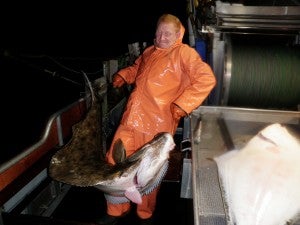By: Wes Erikson
Fisherman Wes Erikson shares his experiences fishing under strict Canadian discard legislation to demonstrate how the Common Fisheries Policy landing obligation can result in sustainably managed and economically viable European fisheries.
My story:
I have not missed a fishing season since I was five-years old. At that time, anyone could go fishing commercially; all you needed was a boat and a strong back (my grandfather used to say a weak mind helped!). Fishing with my father and grandfather at age 16, I skippered a 14-metre salmon troller and at 20, in 1987, I purchased my first vessel – a 15 metre halibut/salmon vessel. When I became a vessel owner, I decided it was important to get involved in the fisheries advisory process, and I remain involved to this day.
My fishery has evolved and matured as a result of concerns that fishermen have regarding safety, illegal activities, and price. Managers, scientists, and ENGOs have added to this with issues surrounding monitoring, accountability, discards, MPA’s, seabird avoidance, and more. Sometimes change was forced upon us, and it is worth noting that fishermen can navigate cannily around any rule. We are natural problem solvers. We have to be, because lost lives and financial ruin are a very possible outcome of problems that arise in our field. This is one of the reasons why “only fishermen can talk to fishermen.”
Co-management gave us the opportunity to be involved in decision making and regulation changes; real co-management, not just talking to fishermen. This requires time, trust, and allowing both parties to make mistakes and learn from them. The industry was given the chance to grow and mature, but growing up is not easy. None of this was easy. In fact, many changes seemed impossible.
In 2002, the Canadian government asked the participants of the groundfish fishery to integrate and account for all rockfish – 7 sectors, 4 gear types. The fear here was that if we could not figure out how to achieve these objectives, they would. The system we designed had to be affordable and workable for both the smallest boat in the fleet (5m) and the largest (60m), and seven fisheries, all with various catches, needed to combine and become fully accountable. Some species–of which there were over 72 to manage with up to 5 management areas per species– were jointly managed between Canada and the USA.
What we did:
We began by selecting an independent professional facilitator and developing guiding principles for how the process would work. As we started this new pilot fishery, I was terrified. The annual individual vessel allowance of some bottleneck species were less than I had discarded on any given day. On top of that, the quota for these species were owned by less than 80 individuals, one of whom speculated on quota just before this initiative was implemented, owned ten percent, and was planning on leasing these scarce species for a premium.
In light of this seemingly unworkable situation, we went fishing anyway. We’re fishermen. It’s what we do. In the first year, we left over fifty percent of those bottleneck species in the water, and the quota owners were left holding onto over half of this so-called valuable quota. Fishermen began cooperating and communicating almost immediately in order to avoid species with low TACs, and if you are a fisherman, then you will understand that this is revolutionary. Since 2006, we have under-harvested every species as a fleet, including the bottleneck species.
Over 300 Canadian vessels participate in the integrated groundfish fishery, under one management plan, with catch shares, an allocation based management tool, for all species and vessels; although each sector had a very different catch share design. Each vessel is accountable for all of its catch, regardless of whether it is retained or released, with logbooks being audited against video footage and compared to the offload. Now that we can trust the data, our logbooks are being used in science and management studies, because the data provides information on total catch mortality– retained and released.
How we did it:
The most important guideline in fisheries management design is to clearly define your objectives, before you identify your participants and begin a consultative process. With enough incentive, any problem can be solved. The four most important components of this fishery are:
- The removal of competition, or, preventing the race for fish
- Individual accountability
- Transferability
- Monitoring
Transferability is an important feature of this management system. It supports selective fishing, staying within allocations, staying safe, and allowing industry to adjust to resource and market dynamics. Vessels are allowed to carry over some level of quota underages and overages from one year to the next, which encourages vessels to fish below their allocation.
There is no guarantee of success here. However, I do know that without these elements in my fishery, we were headed for failure. Many of us now will survive and thrive because the system gives us the flexibility to adjust, take measured risks, and gather the support we need to execute new plans. This has allowed for better working relationships with everyone involved, and we will continue to evolve and mature over time, because this system allows us the flexibility to innovate.










